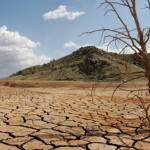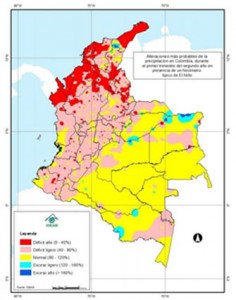
With the looming threat of the El Niño weather phenomenon approaching, a summer drought in Colombia’s north and east is already depriving entire municipalities of water.
Rivers throughout the affected region have fallen to critical levels, as acute water shortages kill livestock and exacerbate the risk of forest fires.
With authorities placing municipalities throughout the Caribbean coast and eastern plains on high alert, high government officials met Tuesday to discuss a plan to deal with the current drought in Colombia and prepare for El Niño, which is expected to begin in the coming months and promises to bring several more months of dry spell.
El Niño is a weather phenomena that is characterized by prolonged droughts, high temperatures, and extreme weather. Colombia’s weather institute has concluded that there is a 70% chance that El Niño begins in July, August, or September, with the winter months, starting in December 2014, expected to bring the most severe effects.
MORE: Colombia to expect floods, heat waves from El Niño in the coming year: meteorologists
In 2010 and 2011, La Niña, El Niño’s positive sister phenomenon, hit much of the country, causing $7.8 billion in economic losses, according to a study published in the Applied Geography journal.
The National Agency for Risk and Disaster Management (NGRD) announced it will be putting aside $18.4 million to execute a four-stage contingency plan in preparation for El Niño’s arrival:
- Prevention and Preparation (May 2014 – September 2014)
- Aid and Attention (October 2014 – April 2015)
- Recuperation (March 2015 – July 2015)
- Evaluation (July 2015 – September 2015)
NGRD has spent $6.3 million in the last five months to help close to 67,000 people affected by the ongoing droughts.
NGRD expects El Niño to increase incidences of sickness in livestock and people, decreases in crop yields, deterioration of ecosystems, coral bleaching, and infrastructure damage.
MORE: Colombia’s agricultural sector requires $25B to prepare for future weather phenomenon
The minister of agriculture recently explained that, in the long-term, the struggling agricultural sector alone will require at least $25 billion in investment to mitigate the effects of extreme weather phenomenon.
The drought before the storm
Regions all over Colombia have been suffering due to the lack of rain in an unusually dry summer. Different states and municipalities have already declared states of emergencies.
While the rainy season in much of the northern coast typically arrives in August, experts are already beginning to ask: If the usual summer dry months are causing this much devastation, how will the country deal with El Niño once it hits?
 |
Though the current drought is not being caused by El Niño, according to Vanguardia news, conditions will only be compounded as El Niño develops.
The next several months will be hard ones for the country, according to Ricardo Lozano, the former director of Colombia’s weather institute (IDEAM). El Niño is set to arrive on the tail end of a first semester already presenting with below average rainfall, reported Vanguardia.
The coastal regions of Colombia, especially the northern states of Atlantico, Magdalena, Bolivar, Sucre, Cesar, La Guajira, and Cordoba, are expected to be the most affected, according to NGRD, as they depend heavily on agriculture and cattle ranching for their economy and food security.
In the eastern grassland plains, a drought earlier this year, which may have been worsened by ongoing water-intense petroleum extraction activities in the region, resulted in the deaths of at least 20,000 livestock and wildlife.
MORE: 20K animals dead in east Colombia drought
The Colombian government has been unable to alleviate the situation in areas already facing water shortages beyond short-term solutions such as subsidies and aid delivery.
Colombia’s agriculture minister announced last week that Colombia’s agriculture budget should be nearly twice the current budget in order to construct the necessary infrastructure the country’s rural sector needs to handle droughts and other weather phenomena.
Alarms all over the country
A red alert has been declared for 24 municipalities in the central state of Antioquia alone due to the risk of forest fires. The municipalities on alert include Colombia’s second biggest, Medellin, as well as the surrounding region, according to National Agency for Disaster Management.
56 documented forest fires have occurred in Medellin, while another 26 occurred in the surround region, according to Colombia’s El Espectador newspaper.
So far this year, 642 forest fires have been reported throughout the country, according to the NGRD.
A report by NGRD states that the agency submitted requests for aerial water-bomber planes and all-terrain vehicles, but the requests were never given financial backing.
The report by NGRD also highlights that energy output of Antioquia’s many dams is also in danger.
An alert has also been placed in the state of Northern Santander by farmers who have had their animals fall sick to to the lack of rain.
“The summer has us beat. We are beat because we don’t have pasture nor where to take the animals,” Tobías Quiroz, a representative of agriculture sector in the state of Norte de Santander told the national El Espectador newspaper.
Countryside and coastal cities most affected
The current drought is most notably taking its toll on cattle and milk production. There are regions in Colombia that have reported a 50% reduction in milk production, according to El Espectador.
MORE: Cattle ranchers ask Colombia’s government to combat effects of drought
A farmer affected by the drought explained, “It is better to sell them because [the animals] are too skinny. We aren’t the animals’ owners; the owners are the people that come and offer a certain value for them, and we have to except what we get because that is all there is,” according to El Espectador newspaper.
According to El Tiempo, the northern tip of Colombia, in the state of La Guajira, has not seen rain in two years. The town of Riohacha had to suspend aqueduct services because the water was coming down from the Sierra Nevada mountains with too much sediment due of the lack of rain in the region.
MORE: Drought in northern Colombia at crisis levels
The NGRD has been accompanying communities in La Guajira, providing 455 tons of food in four months to 48,000 families and trucking in water, but it has not changed the helplessness of the region’s inhabitants, according to El Tiempo newspaper.
The coastal city of Santa Marta, a tourist hotbed, has also been holding out for over six months without rain. Metroagua, the water provider of the city, has contracted 30 tankers to make 100 daily trips to bring in water into the city’s neighborhoods, according to El Espectador. However, the service is said to be inconsistent, prompting citizens to block roads and protest almost daily.
|
The price for a simple bag of water has skyrocketed in Santa Marta, that is of course, when stores have water to sell, according to local residents.
In Yopal, the state capital of Casanare, perhaps the most affected state in the country, citizens have clashed with the mobile riot police who reportedly violently broke-up a protest of 10,000 people, arresting organizers, according to El Tiempo. According to local media, The protest featured placards that said, “I want to shower” and “3 years without water. Where are those responsible? Where is the Inspector General?”
The city of 180,000 inhabitants has been without a water treatment plant after it was destroyed in a landslide caused by heavy rains in May 2011. Since then, the city has suffered through a strong summer drought without a water treatment plant. all the water that comes into the city now is polluted with sediment with no way to filter it. Hepatitis A, adenovirus, and enterovirus has also been detected in the water suppy, according to El Tiempo.
On Saturday, after over 1,000 days, Minister Luis Felipe Henao announced that the funds would be provided by the national government to build an aqueduct to bring water into the Yopal.
Residents of the affected regions have little other than faith to guide them through these times, which promise to get worse before they get better.
Sources
- Activación planes de preparación y contingencia frente a un posible Fenómeno del Niño (NGRD)
- Gobierno Nacional se fortalece técnica y operativamente para la respuesta ante la temporada seca y posible fenómeno de el niño (NGRD)
- Impact of the 2010-2011 La Niña phenomenon in Colombia, South America: The human toll of an extreme weather event (Applied Geography)
- Sin Niño ya la sequía abogia el país (Vanguardia)
- Declaran alerta roja en 24 municipios de Antioquia por riesgo de incendios (El Espectador)
- Sequía genera alarma en Norte de Santander (El Espectador)
- Más de 300 reses han muerto en el Atlántico por sequía (El Espectador)
- Habitantes de Yopal están desesperados sin agua (El Espectador)
- Defensor del Pueblo de Yopal pide que protesta sea pacífica (Portafolio)
- Yopal protesta por falta de agua potable (El Espectador)
- Crisis por clima: guajiros y samarios, azotados por falta de lluvias (El Tiempo)
- Indignación en Yopal y Santa Marta por falta de agua (El Tiempo)
The post Colombia braces for El Niño amid already harsh summer drought appeared first on Colombia News | Colombia Reports.
